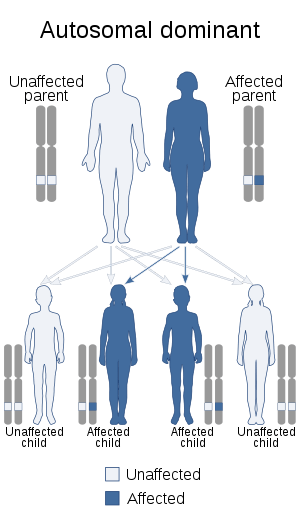STING-associated vasculopathy with onset in infancy
STING-associated vasculopathy with onset in infancy (SAVI[1]) is a rare autoinflammatory vasculopathy associated with the stimulator of interferon genes (STING) protein and characterised by severe skin lesions and interstitial lung disease.
| STING-associated vasculopathy with onset in infancy | |
|---|---|
 | |
| Autosomal dominant pattern is the inheritance manner of this condition | |
| Specialty | Medical genetics |
| Causes | Mutations in the TMEM173 gene |
Signs and symptoms
The onset is in infancy. The skin lesions occur on cheeks, nose, fingers, toes and soles.[2] They may vary in appearance but frequently develop into non-healing ulcers. Interstitial lung disease is also common. All affected children fail to thrive.
Other features include myositis and joint stiffness.
Imaging:
Chest X rays show sign consistent with interstitial lung disease.
Bloods:
Anemia, leukopenia, thrombocytosis, T cell lymphopenia with normal B cells and hypergammaglobulinemia may occur.
Autoantibodies may be present including antinuclear, antiphospholipid, and anticardiolipin antibodies.
The erythrocyte sedimentation rate and C reactive protein levels tend to be raised.
Biopsies:
Skin biopsies show inflammation of the capillaries and microthrombosis. Immunoglobulin M and C3 deposition may be present.
Lung biopsies show alveolitis, follicular hyperplasia, B-cell germinal centers and interstitial fibrosis.
Genetics
This condition is due to mutations in the TMEM173 gene. This gene is located on the long arm of chromosome 5 (5q31.2) and encodes the stimulator of interferon genes (STING) protein. There are 3 disease causing mutations in the dimerization domain of STING that cause SAVI; V155M, N154S, and V147L.
Pathopysiology
This only partly understood. The wild type protein (STING) is normally found in the cytoplasm of the cell. The mutant forms are located in the Golgi apparatus.
Diagnosis
The condition may be suspected on clinical grounds. The diagnosis is made by sequencing the TMEM173 gene.
Treatment
No specific treatment is known. Management is supportive.
Epidemiology
This condition is considered rare, with 9 cases reported in the literature up to 2019.
Research
This condition was first described in 2014.[3] In 2017 a group led by Dr. Jonathan Miner at Washington University in St. Louis created a mouse model of SAVI. Dr. Miner's research team used CRISPR-CAS9 genome editing to introduce a mutation into the mouse STING gene (TMEM173)[4] that was analogous to a human SAVI-associated mutation. These mice, known as STING N153S mice, developed spontaneous lung disease and a severe immunodeficiency to a herpesviruses[5].
References
- Reference, Genetics Home. "SAVI". Genetics Home Reference. Retrieved 2019-02-21.
- Jeremiah N, Neven B, Gentili M, Callebaut I, Maschalidi S, Stolzenberg M-C, Goudin N, Fremond, M-L, Nitschke P, Molina TJ, Blanche S, Picard C, Rice GI, Crow YJ, Manel N, Fischer A, Bader-Meunier B, Rieux-Laucat, F (2014) Inherited STING-activating mutation underlies a familial inflammatory syndrome with lupus-like manifestations. J Clin Invest 124: 5516-5520
- Liu Y, Jesus AA, Marrero B, Yang D, Ramsey SE, Montealegre Sanchez GA, Tenbrock K, Wittkowski H, Jones OY, Kuehn HS, Lee C-C R, DiMattia M A, and 40 others. Activated STING in a vascular and pulmonary syndrome. New Eng J Med 371: 507-518
- Miner, Jonathan J.; Yan, Nan; Platt, Derek J.; Wu, Jianjun; Gonugunta, Vijay K.; Sakai, Tomomi; Miner, Cathrine A.; Smith, Amber M.; Ai, Teresa L. (2017-11-06). "STING-associated vasculopathy develops independently of IRF3 in mice". Journal of Experimental Medicine. 214 (11): 3279–3292. doi:10.1084/jem.20171351. ISSN 0022-1007. PMC 5679177. PMID 28951494.
- Miner, Jonathan J.; Baldridge, Megan T.; Smith, Amber M.; Platt, Derek J.; Miner, Cathrine A.; Ai, Teresa L.; Ingle, Harshad; Bennion, Brock G. (2019-02-15). "A Human Gain-of-Function STING Mutation Causes Immunodeficiency and Gammaherpesvirus-Induced Pulmonary Fibrosis in Mice". Journal of Virology. 93 (4): e01806–18. doi:10.1128/JVI.01806-18. ISSN 0022-538X. PMC 6364005. PMID 30463976.
| Classification | |
|---|---|
| External resources |